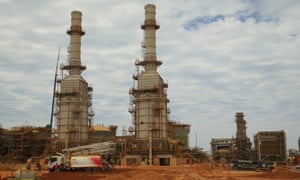Liquefied natural gas developments on a collision course with Paris agreement, Global Energy Monitor says
The booming liquefied natural gas (LNG) industry will play at least
as big a role as new coal investments in bringing on a climate crisis if
all planned projects go ahead, US-based energy analysts and campaigners
say.
The report by the Global Energy Monitor appears at odds with comments by Australia’s emissions reduction minister, Angus Taylor, who has said the country could be proud that the rapidly expanding LNG export industry was displacing coal power overseas.
Government analysis identified LNG as the main reason Australia’s greenhouse gas emissions have risen each year since 2015, but the minister and industry say Australian gas deserves credit for lowering global emissions.
The Global Energy
Monitor, formerly known as CoalSwarm, is a US-based research and
advocacy group that tracks fossil fuel development. It found there were
US$1.3tn in planned LNG investments across the globe, including nearly
$38bn in Australia, putting it fourth on a list behind the US, Canada
and Russia.The report by the Global Energy Monitor appears at odds with comments by Australia’s emissions reduction minister, Angus Taylor, who has said the country could be proud that the rapidly expanding LNG export industry was displacing coal power overseas.
Government analysis identified LNG as the main reason Australia’s greenhouse gas emissions have risen each year since 2015, but the minister and industry say Australian gas deserves credit for lowering global emissions.
Ted Nace, the group’s executive director, said the proposed tripling of global LNG capacity risked introducing decades of emissions of methane, a potent and difficult-to-monitor greenhouse gas, at odds with the Paris climate agreement. The Intergovernmental Panel on Climate Change last year estimated methane emissions would need to be reduced by 35% between 2010 and 2050 to meet the Paris goals.
“The one piece of good news is that most of these projects are in the pre-construction stage so there is still time for a moratorium on LNG infrastructure before we lock ourselves into even more irreversible climate damage,” he said.
A separate study in the journal Nature found existing fossil fuel infrastructure alone, including coal and gas-fired power stations, would almost certainly be enough to push the world beyond 1.5C global heating if not shut down earlier than planned.
Australia’s LNG industry has already more than tripled since 2012 as developments have come online in Western Australia, Queensland and the Northern Territory. A recent government Resources and Energy Quarterly report forecast the value of Australian LNG exports will be nearly $50bn this year, second only to iron ore.
Nace said it was difficult to compare emissions from coal and gas given their different nature. Gas has lower CO2 emissions than black coal when burned for electricity, but LNG developments also leak methane, which is a relatively short-lived gas that lasts in the atmosphere about 12 years but still has a warming power about 28 times greater than the same amount of CO2 when calculated over a century.
A recent study found the level of atmospheric methane has increased significantly since 2007 after a relative flat period. Scientists are unsure why.
Global Energy Monitor researchers found fugitive methane emissions from new LNG extraction and processing would be expected to have as large or larger global heating impact than proposed coal power expansion.
“The truth about LNG is nobody knows what is happening across the supply chain,” Nace said. “But it’s very easy to see leakage of 2% to 3% and if that much gets away into the atmosphere it is significant – it gives a jolt of warming.”
On Taylor’s claim that Australia’s gas was displacing coal in Asia, Nace said it was likely this was true in some places, particularly parts of China, but in others it was being used to meet new energy demand that could be delivered with clean energy.
Taylor has said Australia’s LNG exports had the potential to lower global emissions by up to 148m tonnes last year, equivalent to 27% of Australia’s annual climate pollution. The department reached this estimate by assuming all exported Australian gas was used to replace coal.
The Australian Petroleum Production and Exploration Association chief executive, Andrew McConville, said the Global Energy Monitor study was flawed as it compared the total emissions from coal and gas but did not include a genuine lifecycle analysis, which would show gas had a significantly lesser impact.
He said the association supported a national climate policy that cut emissions at least cost and supported investment decisions “consistent with an international price on carbon”.
“Australia’s oil and gas sector has a vital role to play in meeting the challenge of reducing global emissions,” McConville said.
Nace said LNG developments were on a collision course with the Paris agreement and the declining cost of renewable energy. He said it created the risk of more than US$1tn in stranded assets.
“These are 40-year investments from an industry standpoint,” he said. “Natural gas infrastructure may be competitive in three, four or five years but do people expect it to be competitive with renewables in 15 years?”
Comment was sought from Taylor.

No comments:
Post a Comment